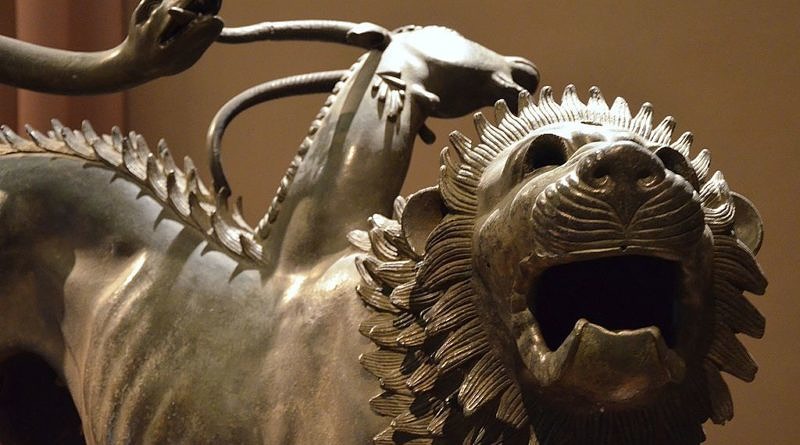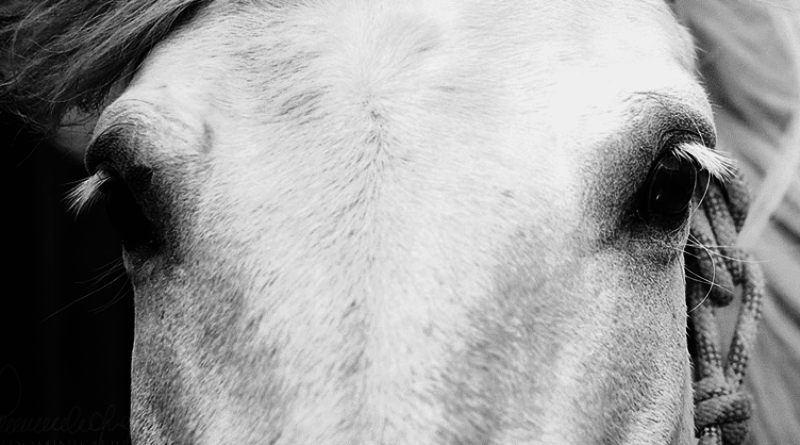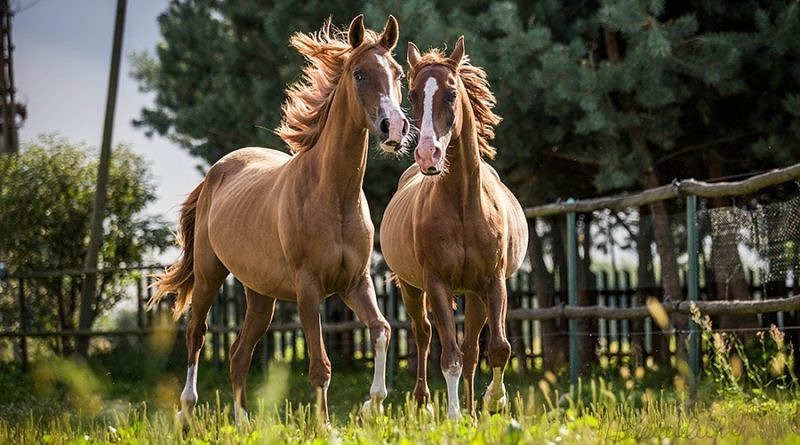In-depth Genetics: Chimeras and other monsters
Chimerism is the result of the fusion of twins in the womb. Find out how you can tell if you or your horse are legendary mosaic ‘monsters’!
The mythical Chimaera was the bizarre sibling of infamous beasts like Cerberus, the guard dog of Hades, and the Hydra of Herculean fame. It had the head of a goat, the body of a lion and a tail that was tipped with the head of a snake. But this legendary mosaic monster lends its name to an altogether much more real phenomenon – though perhaps almost as astounding.
In biology, chimerism is the result of the fusion of two or more fertilised eggs or embryos that merged at a very early stage of development. A chimeric individual therefore contains the DNA of two or more completely separate cell lineages. Because the DNA belongs to siblings at the same stage of development, the now-single embryo that results continues to develop as normal and is eventually born as a single animal. Often, it is impossible to tell that an individual is a chimera – in fact, you could be a chimera yourself and never know!
To think about this another way, chimerism is the result of non-identical twins merging at a very early stage of pregnancy. Identical twins can also merge but because their DNA is, well, identical, it’s not possible to detect. In a chimera, to start with there will only be two cells – the two fertilised eggs, each previously destined to become a different twin, now merged and on a path to producing only one individual. These cells divide and multiply, giving rise to many cell lines, and an embryo forms. Over the course of gestation, these cell lines continue to multiply and differentiate. Controlled by complicated chemical gradients and genetic switches, the cells specialise and form the various parts of the animal.
In humans one way in which chimerism makes itself known is when the two embryos that merged were not the same sex. Depending on how and when the fusion took place, two separate cell lines – one male and one female – can end up contributing to the formation of the reproductive organs. As a result the baby can be born with a mixture of male and female characteristics of varying degrees, or even be a hermaphrodite. However the effect can also be more subtle. Most chimeric individuals are composed of predominantly one cell line or the other.
Occasionally this can result in a great deal of drama and confusion, as one woman discovered when her own children were DNA-tested and found to not be her’s! In this instance, the woman turned out to be a chimera and her ovaries were effectively her sister’s, with cell lines from one embryo having developed into the ovaries, and the other cell line having given rise to the rest of her body. Since DNA tests often use saliva, there was no way to know that her ovaries’ DNA did in fact match her children, even if the rest of her did not.
Very rarely, chimerism in humans will be visible externally as heterochromia (where each eye is a different colour). In other cases patchy skin along characteristic lines can indicate chimerism. For the most part, however, human chimerism is not easily detected and it’s very likely most chimeras go through life never knowing anything about it.
Like human chimeras, chimeric horses are usually the result of only two embryos fusing – as triplets are almost unheard-of. In other animals like cats, chimerism can be the result of more siblings fusing because they regularly have larger litters, though this is still very unusual.
Because chimeras are the result of two siblings merging into one, the genetic possibilities of the coat colour are still limited by the parental genotypes. For instance, two solid chestnut horses not carrying any other traits cannot produce a visibly chimeric individual – because two solid chestnut horses can only ever produce a solid chestnut foal. If two solid chestnuts merge in the womb, there will be no sign at birth that this ever happened!

The patches of colour on a chimera are always composed of patterns and colours that could all exist in foals from the specific stallion and mare pairing that parented them. Most chimeric horses appear to have bold areas of colour over their coats, though it is thought that some forms of brindle may be the result of chimerism as well.
It is probably misleading to call chimerism a “colour”, or even a “pattern”, as many tend to. It is really better thought of as a condition. The phenotype of the individual is the result of chimerism, but the chimerism itself was an accidental occurrence where two siblings merged into one. As such, the phenotypic result of chimerism – the pattern and colour – is not something that can be inherited.
A chimeric individual will pass on whatever genes are found in the DNA that goes into their reproductive cells. As we have seen, this is typically one or other sibling’s DNA – not both at once, and not each interchangeably either.
It is possible for an animal to be predisposed to producing chimeras. This is known to be an adaptive trait in some species and a small increase in likelihood could simply be achieved by females producing multiple eggs at once.
This is mimicked by the effect of in-vitro fertilisation (IVF). Women who undergo fertility treatment involving IVF are more likely to produce a chimeric child because of the number of embryos that are implanted at once to increase the chances of a successful pregnancy. So if you are a test-tube baby, there is a much greater chance that you are also a chimera.
However, there is little evidence that a predisposition to chimerism is heritable in horses (or humans). Even if it was, this would only increase the likelihood of chimerism – not pass on a specific colour or pattern in itself.
Chimerism can occur in any breed of horse. Often chimerism is noticed in breeds that come in a wide range of colours because this increases the chance of a visible phenotype. While we have no way of knowing how many hidden chimeras exist, in its more striking form, it is exceedingly rare.
Chimerism is not the only condition that can produce unusual patterns in horses however. Another phenomenon that is not heritable but produces patches of unexpected pattern is that of the somatic mutation.
A mutation is an alteration in a gene (a mistake in the DNA that makes up the gene) that occurs by chance when DNA replicates. DNA replicates every time a cell divides in order for the new cell to also contain a copy of the DNA. As such, there is a small chance of a mutation happening every time cells multiply – i.e. any kind of “growth”.
Most phenotypic traits have a genetic basis that is inherited. The genes we carry are themselves the result of mutations in our DNA that have occurred and accumulated and shaped and formed new and different genes over the billions of years that life has existed on Earth. When mutations occur in the reproductive organs, the sperm and eggs produced through cell division (meiosis) carry these mutations and can pass them on to future generations.
Some mutations will also occur during development as our cells divide and multiply to form an embryo and many of these will also end up in the reproductive organs where they will then be passed on to future generations, as well as potentially being visible in the phenotype.
Others, however, will occur in cells that are not destined to form reproductive organs. These mutations will be present in some of the individual’s cells but will not be passed down to its offspring – these are the somatic mutations. Throughout life, our cells can continue to multiply for growth or repair and in so doing suffer mutations that are more localised.
An example of a phenotype that results from a localised mutation is cancer. Cancer cells are normal body cells where a mistake has caused certain important genes that control the replication of cells to stop working properly. As a result, the cells multiply uncontrollably, and a tumour forms.
If a localised mutation occurs earlier in development, while the embryo is still forming, it will give rise to a somatic mutation. If this is a harmless colour mutation, it will be visible in the healthy foal’s coat.
“Somatic” is a word derived from the Greek for “body”. In effect, a somatic mutation is a bodily mutation that is not heritable. It is localised but typically present from birth. Mutations that do not cause great damage tend to be very simple alterations in genes, and the more complex the change, the less likely it is to occur. As such, most somatic mutations – if not all – that you will ever come across in horses are the result of a single gene being switched “on” or “off”.
Somatic mutations tend to present themselves as irregular patches of colour in unexpected places. Sometimes the phenotype can be confused with chimerism and sometimes it can be very difficult to tell which is responsible without a genetic test. However, somatic mutations are typically less regular in their distribution and because a somatic mutation can occur at any stage in development, they can take on many forms and be highly variable and evident to a greater or lesser degree. In some cases a somatic mutation will be a small spot of white discolouration where pigment cells did not proliferate to the region fairly late in development. In other cases, a big patch of another colour will be the outcome.
If a patch of colour is present, it will normally differ from the general phenotype by only one “step”. For example, an entirely black horse will not have a palomino patch. To get from black to palomino, both the extension allele to allow black pigment must be switched off to turn the region chestnut and a cream gene must be ‘created’ to dilute the chestnut to palomino. Such a specific two-step process is extremely unlikely.
Whether the horse is homozygous or not for a trait also matters. A black horse that is homozygous for the extension allele (EE) has to switch off both copies to appear chestnut. A heterozygous horse only has to switch off one.
If you study horses with somatic mutations, you will find that most have a secondary colour that only takes one simple step to get to. An example is a black horse with a chestnut patch (Ee to ee) or a bay horse with a black patch (Aa to aa). Similarly white patterns can easily be the result of spontaneous somatic mutations because they represent the switching off of the whole process that produces pigmentation and require only one simple “off” switch to occur. A more familiar example of this phenomenon are “blood marks”, which sometimes (but not always) result from a somatic mutation that stops the grey gene from being expressed.
Furthermore, the mutated area will usually be the colour that results from losing the function of a gene – not gaining a new function. For instance a mutation in the extension allele will produce a chestnut area on an otherwise black horse by inhibiting the black pigment production that normally masks red – but the opposite is not as likely because going from chestnut to black requires that a very specific protein be produced that the horse’s genes do not code for already (see What determines a horse’s colour?). The more specific the change, the less likely it is to occur.
In addition, any white patterns the horse has (such as tobiano) will usually override local simple somatic mutations. A horse with a black-to-chestnut somatic mutation, for example, will still have the white marking over the top of the black region. This is because white is the result of switching off all pigment cell migration – it’s one step before the somatic mutation that gives the chestnut patch and will thus mask it. This is in contrast with chimeric individuals where white markings may be interrupted by the alternate genotype. Regardless of the phenotype, somatic mutations, by definition, cannot be passed on to offspring.
Both chimerism and somatic mutations can produce very striking outcomes. Next time you see a horse with very unusual markings, see if you can figure out if it is a chimera or has a somatic mutation – or is something else entirely!







